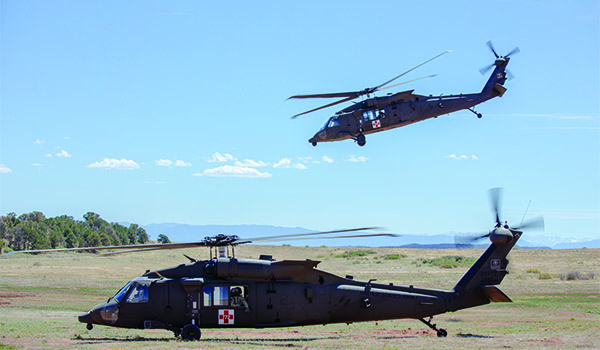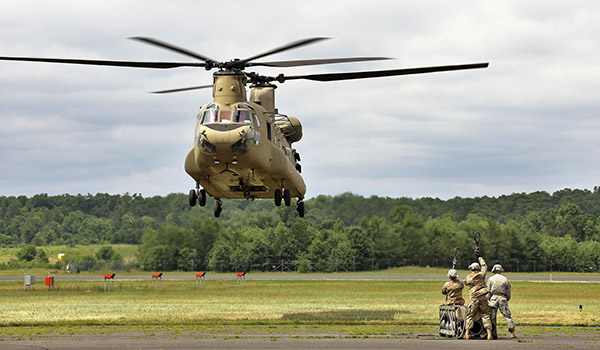
This is your Army Reserve / By COL Roger Deon and LTC Amy Buck: COVID-19 Response – ECAB mobilizations are enabled by experienced air crews with a proven ability to adapt to rapidly emerging requirements in complex environments. Their specialized skillsets and readiness posture allowed for seamless support to the Nation’s COVID-19 defense response and the Army’s refocused mission to protect the force, posture the force to maintain global operational readiness and support the national effort to fight against and mitigate the impact of COVID-19.

Company C, 7th Battalion, 158th Aviation Regiment, 11th Expeditionary Combat Aviation Brigade, arrives at a simulated point of injury during a multi-ship flight on Fort Carson, Colorado, May 18, 2020./ U.S. ARMY PHOTO BY SGT. ALEXANDER MORGAN
Army Reserve fixed wing battalions were immediately employed in transporting medical personnel and key leaders, as well as test kits and COVID samples. Shortly thereafter, they were called to transport Army Reserve Urban Augmentation Medical Task Forces to places of greatest need, primarily along the east coast. Mitigating exposure to the virus, Army Reserve Fixed Wing aircrews conducted more than 1,000 missions, moving in excess of 3,000 personnel to some of the hardest-hit areas.
Double Eagle Express

U.S. ARMY RESERVE PHOTO BY MSG MICHEL SAURET
Due to COVID-19 travel restrictions and the self-quarantine requirements associated with commercial air travel, there was an unprecedented demand for Military Air in the weeks and months following the start of the pandemic. In response, the Army Reserve established a team of aviation experts dubbed “The Double Eagle Express” in March 2020. They focused on streamlining processes and providing a single point of contact to assist with military air flight requests and liaison with ARAC and Operational Support Airlift Agencies. To date, the Double Eagle Express processed nearly 800 individual flight or mission requests.
Training and Readiness in a COVID Environment
Army Reserve aviation units, consisting primarily of part-time Troop Program Unit (TPU) Soldiers, are held to the same Aircrew Training Program (ATP) standards as their active duty counterparts. In order to meet these common training requirements, Army Reserve air crew members perform up to 72 additional flight training periods (AFTP) throughout the year, while also maintaining civilian careers. When Operation Northern Strike, a preeminent joint maneuver training exercise, was canceled due to COVID-19, the ARAC adapted its collective training. The requirement was to provide individual and unit training validation opportunities for aircrews and ground support personnel.
For example, “Mountain Medic” was created as an individual and collective medical evacuation (MEDEVAC) training event when Global Medic 2020 was cancelled due to COVID-19. Aviators and flight crews flew from G Company, 7th Battalion, 159th Aviation Regiment, Los Alamitos, California to Fort Carson, Colorado to train and validate the medical evacuation capabilities of the 11th ECAB. By incorporating their sister company, C Company, 7th Battalion, 159th Regiment, as trainers and evaluators, both of the 11th ECAB’s MEDEVAC companies were able to simultaneously build individual and crew readiness.
Training and maintenance included both daytime and nighttime operations, in direct support of 10th Special Forces Group and 4th Infantry Division Forward Support Surgical Team, all while implementing measures to mitigate the risk posed by COVID-19. Events ranged from live hoist operations at high altitude to patient transfer, meanwhile other Soldiers trained and validated the medical skills and readiness of flight paramedics.
Ready Now
Even amid the pandemic, the U.S. Army Jet Training Detachment (USAJTD) maintains the Army’s highest level of excellence in training, safety, logistics, and support for the Army’s fixed-wing UC-35 enterprise. Despite the challenges of the past year, the USAJTD continues its force generation requirements, building on past success while mitigating pandemic risks. Currently, the USAJTD conducts nine UC-35B Aircraft Qualification Courses and seven UC-35 Instructor Pilot Courses per training year.

Students in the 89B Ammunition Supply Course prepare to connect a mock ammunition pallet to a Chinook helicopter as part of sling load training at Sparta-Fort McCoy Airport at Fort McCoy, Wisconsin. / U.S. ARMY RESERVE PHOTO BY SCOTT T. STURKOL
The ARAC’s enduring missions carried on throughout the pandemic. CH-47F Chinook aircrews provided aerial fire suppression support at Yakima Training Center, Washington from May to September 2020, and Army Reserve pilots with seven crew members and eight park rangers rescued three stranded climbers from a 14,300 foot precipice near Mt. Rainier’s summit.
Since Army Reserve aviation maintains a relatively high operational tempo, safety must be at the forefront of daily operations. This requires organic support from the Aviation Support Facilities at each flight activity. Aviation Support Facilities and civilian Military Technicians are unique because of their dedication to support the unit and aircraft. Army Reserve aircraft may remain in units for more than a decade – maintained by the same facility and, in some cases, the same technician, lending a sense of pride in ownership.
Demonstrating that pride, the 13-month Historical Equipment Material Status Report, part of the Army’s Common Operating Picture, shows how Army Reserve aviation is maintaining readiness – and even leading the way – in a COVID-19 environment. The Army Reserve recently achieved among the Army’s highest operational readiness rate in three years, with Black Hawks reaching 85% readiness and Chinooks attaining an unprecedented 97% readiness. According to the report, the Army Reserve met or exceeded HQDA’s aircraft readiness goal of 75% Fully Mission Capable for the last 15 consecutive months.
Shaping Tomorrow
Army Reserve Aviation stands ready to provide continued support to COVID-19 defense operations across the U.S., while Soldiers of the 11th ECAB are preparing for one of the largest deployment missions in Army Reserve Aviation history. During the upcoming months, over 1,200 Soldiers will support Operation Spartan Shield (OSS) in Kuwait, Jordan, Syria, and Iraq. While deployed, they expect to engage in 24/7 full-spectrum operations, including heavy-lift air traffic services and movement of personnel.
As the Army Reserve looks to shape its future structure and capabilities, Army Reserve aviation demonstrates that our Soldiers are ready now, to provide mission-critical forces and capabilities to the Army and Joint Force in support of U.S. national security interests and Army commitments worldwide.
COL Roger Deon and LTC Amy Buck are the director and deputy director of Aviation and Watercraft, U.S. Army Reserve Command, Fort Bragg, NC.










